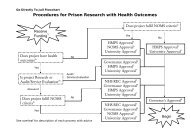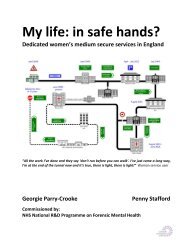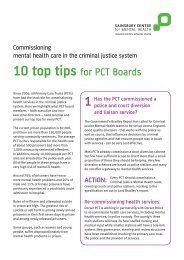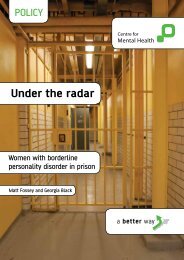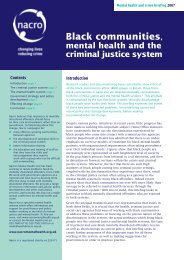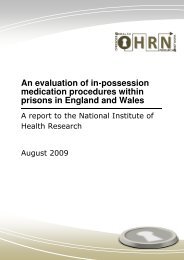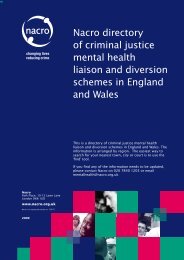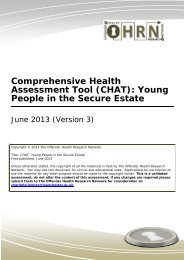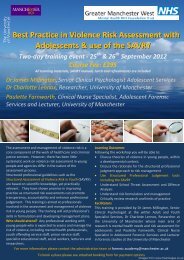Chapter Five:<strong>Justice</strong> Needs WomenWomen as Workers in the Criminal <strong>Justice</strong> SystemNotably, women make up a high proportion of seniorlawyers within the Government legal service, where greateremphasis is placed on flexibility.Interestingly, law firms are not immune <strong>from</strong> outsidepressure, particularly when it comes <strong>from</strong> one of their ownclients. General Counsels have at times used their influence<strong>to</strong> push diversity up the agenda. For example, BT has builtdiversity in<strong>to</strong> their selection processes for outside law firms.While, Tyco International went so far as <strong>to</strong> set staff diversitytargets (and a bonus if they were met) <strong>to</strong> its law firm,Eversheds. 223 <strong>The</strong> Commission commends this practice.At the <strong>to</strong>p 30 sets of the UK bar, there are only 42 femalecompared <strong>to</strong> 479 male silks. 224 In 2008/9, 87 men wereappointed as Queen’s Counsel compared <strong>to</strong> 16 women. Ofparticular concern <strong>to</strong> the Commission, as Table Five reveals,is that the number of women applying for QC is at its lowestlevel for ten years. It was hoped that the changes <strong>to</strong> theQC selection process in 2006 which introduced a moretransparent process, would lead <strong>to</strong> an increase in femaleapplicants, particularly now that the initial self assessmentfilter has been removed and diversity is a competency inits own right within the selection framework. However,while the success rate for female applicants is improving,the small pool of applications <strong>from</strong> women needs <strong>to</strong> beaddressed. <strong>The</strong> Queen’s Counsel Appointments SelectionCommittee should work with the Judicial AppointmentsCommission <strong>to</strong> share best practice and methods forincreasing the pool of women applicants.This inequality in outcome (such as the small numbersof women applying for silk) which continues <strong>to</strong> exist canbe attributed <strong>to</strong> his<strong>to</strong>rical inequalities as well as the highattrition rate among female barristers. <strong>The</strong> bar continues<strong>to</strong> be a male-defined environment with implicit and explicitinstitutional structures and practices which have the effec<strong>to</strong>f disadvantaging women. Women now join the Bar inroughly equal numbers <strong>to</strong> men. However in 2007, 30.94percent of self-employed practitioners were women whils<strong>to</strong>nly 19.5 percent of self employed practitioners withover 15 years experience were women. 226 Further, anunpublished report dated May 2008 based on a survey ofmore than 3,600 barristers showed that on average menearn almost £100,000 (gross billed income) more thanwomen per annum. 227Barriers <strong>to</strong> progression <strong>to</strong> the senior levels of bar can befound in the culture of the profession. For example, theself employed bar involves expectations <strong>to</strong> work longhours; travel on short notice, a lack of flexibility includingno provision for maternity or caring leave and financial risk.<strong>The</strong>se expectations adversely impact on women and singleparents resulting in many leaving the profession. A BarCouncil study of barristers ceasing self-employed practice,found that the number of women who began a tenancybetween the years 1988 and 1998, and who ceased <strong>to</strong>practise between the sixth and tenth years of call wasnearly twice that of men. 228 Even the process for appointingSilks will disadvantage women who have taken a break(s) inTable Five – Queen’s Counsel Statistics, 2009 225Totalapplicants1998 1999 2000 2001 2002 2003 2006 2007/08 2008/09511 553 506 456 429 394 443 333 247Total awards 60 69 78 77 113 121 175 98 104MaleApplicants 465 504 453 405 385 355 374 276 215Awards 50 60 68 67 101 112 141 78 87FemaleApplicants 46 49 53 51 44 39 68 51 29Awards 10 9 10 10 12 9 33 20 16Page 72
her career, as these women may find it harder <strong>to</strong> meet therequirements for judicial and other references. <strong>The</strong> cost ofthe Silk application may also preclude some women withthe application fee for the third competition currently £2,500plus VAT and a further fee of £3,500 plus VAT payable bysuccessful applicants on appointment.…When I was at the bar I did feel that I was discriminatedagainst. After having my first child I returned <strong>to</strong> chamberson a part time, three days a week basis. After I had mysecond child, when I came back <strong>from</strong> maternity leave theclerks had done absolutely nothing <strong>to</strong> get me any work(they had not even written <strong>to</strong> solici<strong>to</strong>rs <strong>to</strong> tell them that Iwas returning, although the date had been fixed for somemonths). I complained about this but little was done. I thenrequested <strong>to</strong> be allowed <strong>to</strong> pay my chambers rent on a prorata basis as I was only in three days a week but receivedthe response that my desk was available <strong>to</strong> me five days aweek and there was no reason why members of chambersshould have <strong>to</strong> subsidise me because I choose <strong>to</strong> stay athome for some of the time. I left practice shortly thereafter.My general experience at the Bar was that there appeared<strong>to</strong> be no discrimination against women who did not havechildren, or who did have children but were prepared <strong>to</strong>return <strong>to</strong> work without making any adjustment <strong>to</strong> the wayin which they worked, but those who wished <strong>to</strong> work parttime,or had geographical or time restrictions because oftheir childcare commitments, were effectively written off.Former Female Barrister, Questionnaire Response,February 2009Women are also often pigeonholed in<strong>to</strong> practising within thestereotypically ‘acceptable’ areas for women, such as familylaw. As one woman <strong>to</strong>ld the Commission, “my clerk…pushed me in<strong>to</strong> family work when my background was civil/commercial.” 229<strong>The</strong> Commission supports the recommendation madeby the Entry <strong>to</strong> the Bar Working Committee in relation<strong>to</strong> retention, including that equality and diversity trainingshould be made compulsory for all barristers as part of theircontinuing professional development requirements andthat a men<strong>to</strong>ring policy, particularly for women who takematernity leave or career breaks, is adopted by Chambersand relevant employers. 230<strong>The</strong> Courts and theJudiciary<strong>The</strong> lack of diversity in the Judiciary has remained a majorconcern for the Commission since its inception. <strong>Justice</strong>needs <strong>to</strong> be accessible and responsive <strong>to</strong> all citizens,irresponsive of gender. As Lady Brenda Hale, the firstfemale Judge <strong>to</strong> be appointed <strong>to</strong> the House of Lords, whenasked about the lack of female judges, commented:This matters because democracy matters . . . We arethe instrument by which the will of the Parliament andGovernment is enforced upon the people. . . Judgesshould be no less representative than the politicians andcivil servants who govern us. 231Judges should more accurately reflect the diversity ofsociety in order <strong>to</strong> ensure that there is public confidencein the system particularly <strong>from</strong> the female population.Further, women can bring new and unique perspectives<strong>to</strong> the bench based on their experiences, concerns andinterests. As Lady <strong>Justice</strong> Arden, stated in her address <strong>to</strong>the Association of Women Barristers “It is that potentialfor different perspectives that men and women often havethat in my view has the potential <strong>to</strong> enrich judicial decisionmaking.”232In April 2008, of the 3820 Judges in England and Wales,just under 20 percent were women. 233 <strong>The</strong> EHRC report in<strong>to</strong>Sex and Power in 2008, revealed that women representedonly 9.6 percent of the senior judiciary (high court judgeand above) and that at this current rate of progress itwould take another 55 years <strong>to</strong> achieve an equal numberof senior female and male judges. 234 According <strong>to</strong> the mostrecent figures currently available, just over ten percent ofthe 109 High Court Judges are women and just over eightpercent of the 37 Court of Appeal Judges are female. 235This represents particularly poor progress, especially incomparison <strong>to</strong> the proportion of female judges in otherinternational senior courts (see Table Six). As <strong>Justice</strong> LadyArden stated:<strong>The</strong>re are far fewer woman Judges in England and Walesthan in many other jurisdictions throughout the world... 236Page 73




